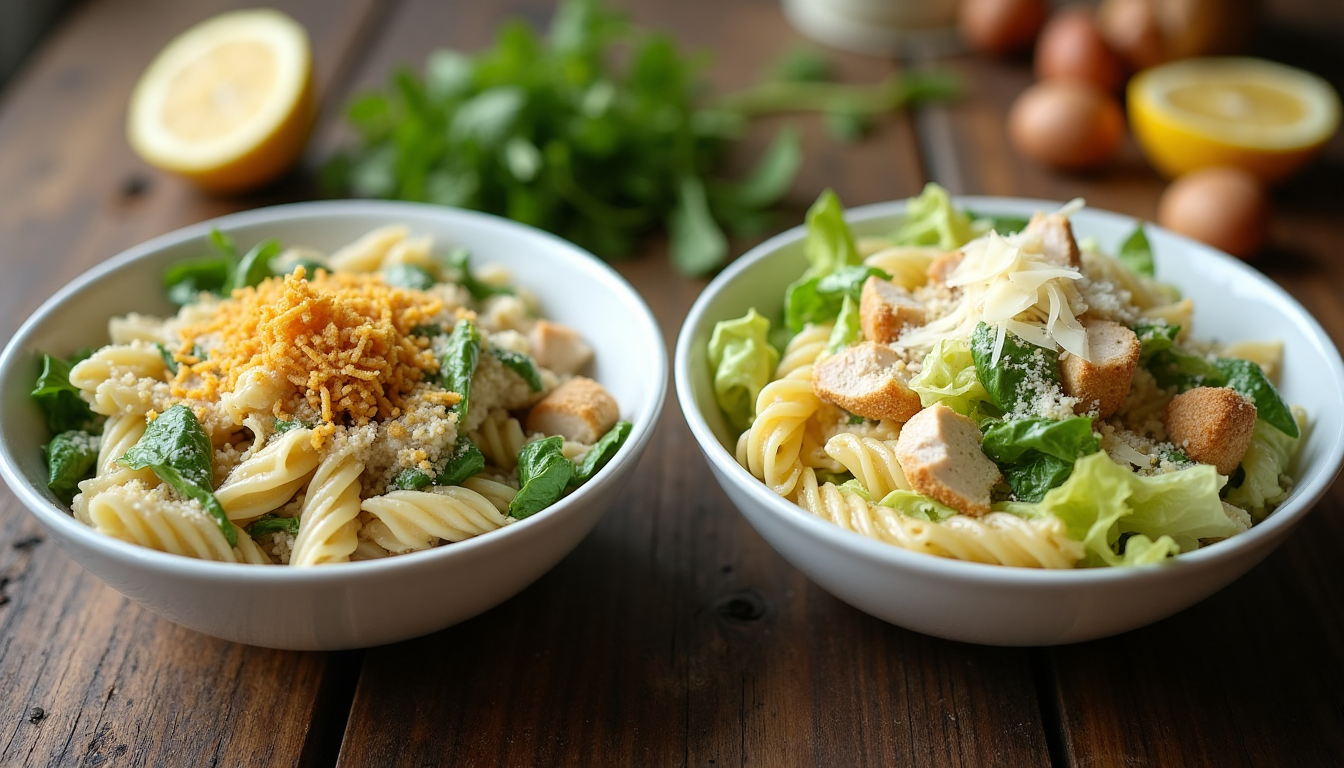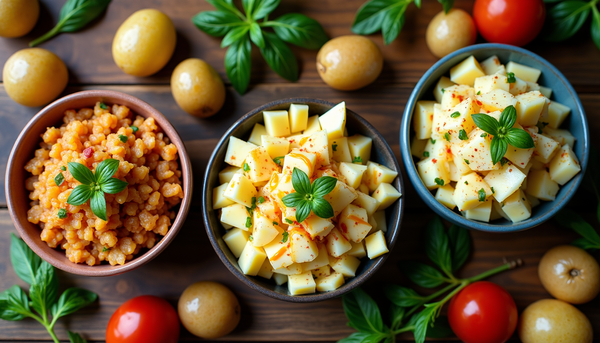Why Your Caesar Pasta Salad Sucks (And How Mine Doesn't)

Look, I'm gonna start this with what might be a hot take: most pasta salads are terrible. Like, genuinely awful. They're either drowning in mayo-based dressing that tastes like cafeteria food, or they're so bland they make cardboard jealous.
But Caesar pasta salad? That should be different, right? It's got that legendary Caesar dressing, the umami bomb of Parmesan, the crunch factor... except 99% of the time, it's still disappointing. And I know this because I spent three summers making absolutely terrible versions of it.
My Caesar Pasta Salad Dark Ages
Picture this: 2019, I'm hosting my first "real" dinner party (you know, the kind where you actually clean your bathroom beforehand). I decided to make what I thought would be a crowd-pleasing Caesar pasta salad. Simple concept, right? Take everything people love about Caesar salad, add pasta, boom.
The result was... tragic. The lettuce went limp and weird. The croutons turned into soggy bread chunks that had the texture of wet cement. The whole thing looked like someone had taken a perfectly good Caesar salad and left it out in the rain.
My friends were polite about it (bless them), but I knew. I knew I had committed a culinary crime.
The Lightbulb Moment
Fast forward to last spring, and I'm debugging some particularly nasty code at work when it hits me. The problem with most Caesar pasta salads isn't the concept - it's the execution. It's like trying to run legacy software on a new system without adapting the architecture.
(Yeah, I know, I'm one of those people who thinks in tech metaphors. Sorry not sorry.)
The issue is that everyone treats it like a regular Caesar salad that just happens to have pasta in it. But pasta changes everything. It absorbs moisture differently, it needs different timing, and those traditional croutons? They're basically designed to fail in this context.
Why Most Caesar Pasta Salads Are Broken
Here's where everyone goes wrong, and why your previous attempts might have been... less than stellar:
The Crouton Problem: Traditional croutons are meant to stay crunchy for maybe 20 minutes max before they start getting soggy. In a pasta salad that's sitting in dressing? They're dead on arrival. It's like trying to keep ice cream frozen in a microwave.
The Lettuce Logistics: Romaine lettuce wants to be dressed at the last possible second. But pasta? Pasta actually gets better when it has time to absorb flavors. This creates a timing conflict that most recipes just... ignore.
The Dressing Dilution: Pasta is thirsty. Really thirsty. It'll drink up your carefully balanced Caesar dressing and leave you with bland noodles and under-dressed lettuce.
The Temperature Trap: Hot pasta wilts lettuce. Cold pasta doesn't absorb flavors well. Most people don't plan for this.
The Breadcrumb Revelation
So here's my solution, and honestly, it's so simple I felt dumb for not thinking of it earlier: forget the croutons entirely. Make garlicky breadcrumbs instead.
I'm talking about proper breadcrumbs - not the sawdust stuff from a canister, but actual Panko that you toast with butter and garlic until it's golden and fragrant. These little flavor bombs don't get soggy (well, not quickly anyway), and they distribute more evenly throughout the salad.
The first time I made these breadcrumbs, I may have eaten half of them straight from the pan. They're that good. My roommate caught me doing this and gave me a look that was equal parts judgment and understanding.
The Method to My Madness
Okay, so here's how I actually make this thing work:
Step 1: Pasta Prep (The Foundation) Cook your pasta - I usually go with farfalle because those little pockets hold onto the dressing nicely - but here's the key: slightly undercook it. Like, just barely al dente. It's going to continue absorbing moisture from the dressing, so you want to give it room to grow, so to speak.
And for the love of all that is holy, salt your pasta water properly. It should taste like seawater. This is pasta 101, but I'm mentioning it because I once watched a friend cook pasta in basically unsalted water and I'm still recovering from the trauma.
Step 2: The Chicken Situation Season your chicken like you mean it. Salt, pepper, and don't be shy about it. I usually do this about 30 minutes before cooking to let the seasoning really penetrate.
Cook it in a hot pan with some olive oil until it's golden and just cooked through. Then - and this is important - let it rest before you slice it. Cutting into hot meat immediately is like releasing all the juices you worked so hard to keep inside.
Step 3: The Magic Breadcrumbs This is where the magic happens. Melt some butter in a pan (use the same one you cooked the chicken in for extra flavor), add minced garlic, and let it get fragrant. Then add your Panko breadcrumbs and toast them until they're golden brown.
The smell at this stage is intoxicating. Like, you'll want to bottle it and wear it as cologne. (Please don't actually do this.)
Step 4: Assembly Logic Here's where my programmer brain really kicks in. You've got to think about the order of operations:
- Cool pasta completely (rinse with cold water, shake off excess)
- Toss pasta with about 2/3 of your Caesar dressing
- Add sliced chicken
- Add chopped romaine
- Add remaining dressing
- Toss gently (keyword: gently)
- Top with fresh Parmesan and those magical breadcrumbs
The key is that the pasta gets first dibs on the dressing, then everything else gets layered in carefully.
Where I've Messed This Up (So You Don't Have To)
Let me save you some pain by sharing my failures:
The Great Overdressing Disaster of 2021: I thought more dressing = better flavor. Wrong. The whole thing became a soupy mess that looked like it belonged in a cafeteria steam tray.
The Premature Breadcrumb Incident: I added the breadcrumbs too early and they turned into sad, soggy bits of sadness. Now I add them literally right before serving.
The Warm Pasta Experiment: I thought maybe slightly warm pasta would absorb flavors better. It did. It also turned my beautiful crisp lettuce into wilted green sadness.
Level Up Your Game (Variations That Actually Work)
Once you've mastered the basic version, here's where you can get creative without breaking everything:
The Protein Swap: Chicken is classic, but I've had great success with grilled shrimp (cook it just until pink), crispy bacon (obvious winner), or even roasted chickpeas for a vegetarian version that doesn't suck.
The Veggie Addition: Blanched asparagus is fantastic here. So are halved cherry tomatoes, but add them at the very end or they'll make everything watery.
The Cheese Upgrade: Sometimes I'll add small mozzarella balls along with the Parmesan. It's not traditional, but neither is putting Caesar salad on pasta, so we're already in uncharted territory.
The Herb Situation: A little fresh basil or even some chopped fresh rosemary in the breadcrumbs can be incredible.
The Make-Ahead Strategy
Real talk: this is actually better if you make part of it ahead. The pasta can sit dressed for a few hours and will actually improve. But - and this is crucial - keep the lettuce and breadcrumbs separate until serving time.
I usually prep everything in the morning for a dinner party, then do final assembly right before guests arrive. It's like meal prep, but for people who actually want to enjoy their food.
Why This Actually Matters
Look, at the end of the day, we're talking about pasta salad. It's not going to change your life or solve world hunger. But there's something to be said for taking a simple concept and executing it properly.
Maybe it's my perfectionist programmer brain, but I think if you're going to make something, you might as well make it well. Plus, there's real satisfaction in watching people take that first bite and get this surprised look on their face because it's actually good.
Your Turn
So here's my question for you: what's your pasta salad disaster story? Because I know you've got one. We've all been there - standing in the kitchen, looking at a bowl of disappointment, wondering where we went wrong.
And if you try this version, let me know how it goes. Did you make any modifications? Any happy accidents that turned out better than planned? I'm always looking for new ways to improve the recipe, because honestly, cooking is just continuous iteration anyway.
Trust me on the breadcrumbs though. They're a game-changer.




